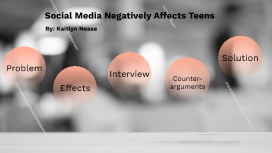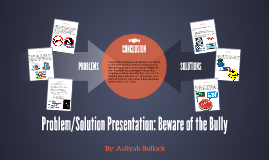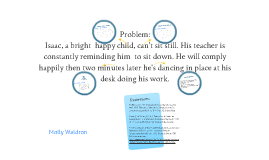problem/solution presentation
Transcript: Social Media Negatively Affects Teens By: Kaitlyn Nease Problem Many teens are affected by the negative impacts of social media Some issues are mental health related while others have impacts on their personal relationships Problem Proper self-control and time management should be taught to teens to reduce the increase of the issues resulting from social media. Effects Some may include: Addiction Negative Self-esteem Anxiety Cyber-bullying Poor reputation Effects from social media Addiction Addiction Teens fall behind in school 50% of teens say they feel addicted to their mobile device, as well as 59% of parents feel their teen is addicted to their mobile device. (Monroe) Withdrawal from in person conversation Self-esteem Self-esteem Tends to decrease with the increase of social media loss of self-esteem, especially in teenage girls, when they compare themselves negatively with artfully curated images of those who appear to be prettier, thinner, more popular and richer. (Miller) Anxiety Anxiety People may experience anxiety and withdrawals when unable to check social media Social media’s constant updates leads many individuals to frequently compare themselves to others, which makes them feel inadequate. (Groundwork) A UK government study found that 41% of children who spend over three hours on social media on a normal school day reportedly suffer from mental health difficulties compared with 21% who spend no time on the sites.("Office") Cyber-bullying Cyber-bullying 65% of 8–14-year-old's have been involved in a cyber-bullying incident (“Internet") Children and teens are mostly affected by this, they are often unsure of how to handle it. This eventually can cause teens distress and even depression. Reputation Reputation Things you post on social media can last with you forever Small misunderstandings may cause major harm A 2018 Kaplan Test Prep survey found that 25% of college admissions officers checked an applicant's social media to learn more about them. 42% of these admissions officers discovered information that had a negative impact on prospective students' admission chances. Heather Bullock, Ed.S, LPC Lead Mental Health Counselor Focused questions around how she has seen students impacted by social media Torn between social media being positive and negative Interview Counter-arguments Counter-arguments Social media spreads information faster than any other media. Social media makes it very easy to connect with friends and family as well as making new friends Solution Solution Create a purpose for using the social media app Set limitations Create a positive social media environment Parents should inform their children of the negative impacts of social media Create a purpose Create a purpose for using social media such as checking a page newsletter, searching for an item on Facebook Marketplace, or checking to see if your friend has made a new post. Avoid using social media due to being bored Purpose Set limitations on social media use Limitations • View screen time and set a reasonable goal • If you go over goal, delete the app for the day Create a positive social media environment Positive environment Follow accounts that motivate you Follow positive influencer's Avoid following accounts that you feel yourself comparing your life to Parental Supervision Parental supervision set limits on screen time inform children on dangers monitor what sites are being accessed Works Cited Farid, Sahir. “Teen's Social Media Use Is Drastically Increasing.” Digital Information World, 12 Oct. 2018, https://www.digitalinformationworld.com/2018/10/frequency-of-teenagers-social-media-use.html. Groundwork Counseling. “Is Social Media Increasing Your Anxiety? Orlando Anxiety Counselor Shares.” GroundWork Counseling, 23 Mar. 2017, http://www.groundworkcounseling.com/anxiety/is-social-media-increasing-your-anxiety-orlando-anxiety-counselor-shares/#:~:text=Research%20has%20shown%20that%20social%20media%20causes%20an,themselves%20to%20others%2C%20which%20makes%20them%20feel%20inadequate. Hill, Lexi. “Do You Think That Following an Influencer Has Affected Your Self-Image? .” How Does Social Media Affect Users’ Self Esteem?, 21 Nov. 2017, https://columbiavoice.cic.sc.edu/how-does-social-media-affect-users-self-esteem/. “Internet Statistics.” GuardChild, GuardChild, 2021, https://www.guardchild.com/statistics/. Works Cited Cont. Works Cited Cont. Joann Pan, “Tweets at the Tables? More of Us Mix Social Media and Food,” mashable.com, Feb. 29, 2012, https://mashable.com/archive/social-media-and-food Kaplan Test Prep, “College Admissions: The Complete Guide to Social Media,” kaptest.com, July 31, 2018 Miller, Caroline. “Does Social Media Cause Depression?” Common Sense Media: Ratings, Reviews, and Advice, https://www.commonsensemedia.org/mental-health/does-social-media-cause-depression#:~:text=Another%20theory%20about%20the%20increase%20in%20depression%20is,to%20be%20prettier%2C%20thinner%2C%20more%20popular%2C%20and%20richer Missouri

















